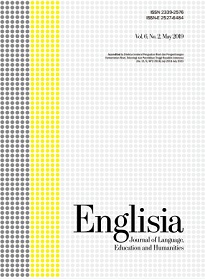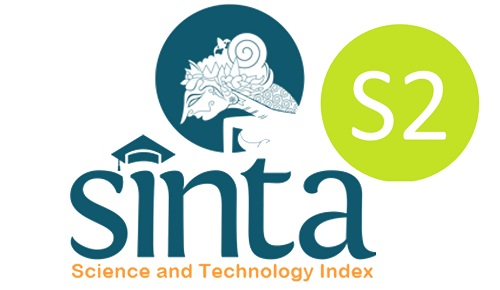An error analysis on EFL students' writing
DOI:
https://doi.org/10.22373/ej.v9i2.11386Keywords:
Error analysis, Writing, ThesisAbstract
This study attempts to analyze the grammatical errors in the writings of Indonesian EFL students through the Error Analysis (EA) approach. The subject of this research included the theses which are written by the university students of English Letters Department at one of the State University, Jakarta. The data sources were taken from chapter four, the conclusion, and the suggestion section from six students’ theses. In this study, the data collection was carried out through several steps: the authors collected data from students, identified grammatical errors, classified errors in students' thesis to determine the frequency of errors, and calculated the data into percentages. The results indicate that there are eleven types of errors commonly found in students’ writing. They are 5% errors of subject-verb and agreement, 2% errors in word order, 13% errors in preposition, 20% errors in article, 2% errors in plurality form, 19% errors in punctuation, 5% errors in auxiliary, 21% errors in unnecessary words, 5% errors in word choice, 5% errors in parallel structure, and 2% errors in redundancy. The writer observed 125 total errors. The errors are dominated in the form of punctuation, article, and unnecessary words types. The research unveils that students make common grammatical errors encouraged by the incapability to accomplish, recognize and understand the rules of the foreign language and its limitations, a little mastery of grammar and vocabulary.
Downloads
References
Akmal, A. (2017). The equivalences translation of the commissive utterances in serdadu kumbang by Rain Chudori Soerjoatmodjo an english-indonesian novel. UIN Syarif Hidayatullah Jakarta.
Ananda, R., A. Gani, S., & Sahardin, R. (2014). A Study of Error Analysis from Students’ Sentences in Writing. Studies in English Language and Education, 1(2), 82. https://doi.org/10.24815/siele.v1i2.1828
Andrian. (2015). An Error Analysis of EFL Students’ English Writing. English Education Journal, 6(4), 511–523.
Arikunto, S. (2002). Prosedur Penelitian: Suatu Pendekatan Praktek. Rineka Cipta.
Ariyanti, A., & Fitriana, R. (2017). EFL Students’ Difficulties and Needs in Essay Writing. 158(Ictte), 111–121. https://doi.org/10.2991/ictte-17.2017.4
Ariyanti, Ariyanti. (2016). The Teaching of EFL Writing in Indonesia. Dinamika Ilmu, 16(2), 263. https://doi.org/10.21093/di.v16i2.274
Brown, H. D. (2007). Principles of Language Learning and Teaching (5th ed.). Longman.
Coleman, J. A. (2006). English-medium teaching in European higher education. Language Teaching, 39(1), 1–14. https://doi.org/10.1017/S026144480600320X
Crystal, D. (2003). English as a Global Language (2nd ed.). Cambridge University Press.
Dulay, H., Burt, M., & Krashen, S. (1982). Language Two. Oxford University Press.
Ellis, R. (1994). The Study of Second Language Acquisition. Oxford University Press.
Ellis, R., & Barkhuizen, G. (2005). Analysing Learner Language. Oxford University Press.
Fandi, D. (2014). Translation procedures and meaning equivalence in subtitle of the animated movie monsters university. UIN Syarif Hidayatullah Jakarta.
Fareed, M., Ashraf, A., & Bilal, M. (2016). ESL Learners’ Writing Skills: Problems, Factors and Suggestions. Journal of Education & Social Sciences, 4(2), 83–94. https://doi.org/10.20547/jess0421604201
Fenton-Smith, B., Humphreys, P., & Walkinshaw, I. (Eds.). (2017). English Medium Instruction in Higher Education in Asia-Pacific: From Policy to Pedagogy. Springer International Publishing.
Floranti, A. D. & H. N. A. (2019). Grammatical Error Performances in Indonesia EFL Learners’ Writing. Indonesian Journal of English Language Teaching and Applied Linguistics, 3(2).
Gunantar, D. A. (2016). the Impact of English As an International Language on English Language Teaching in Indonesia. The Impact of English As an International Language on English Language Teaching in Indonesia, 10(2), 141–151. https://doi.org/10.15294/lc.v10i2.5621
Irmalia, M. (2016). Indonesian Interference in Students’ Writing. English Education Journal (EEJ), 7(4), 496–508.
James, C. (2013). Errors in Language Learning and Use: Exploring Error Analysis. Routledge.
Jenkins, J. (2009). World Englishes: A Resource Book for Students. Routledge.
Jenkins, J. (2014). English as a Lingua Franca in the International University: The Politics of Academic English Language Policy. Routledge.
Keshavarz, M. H. (2012). Contrastive analysis and error analysis. Rahnama Publications.
Khaleda, N. (2017). The main character’s hierarchy of needs in the girl on the Train Novel. UIN Syarif Hidayatullah Jakarta.
Kirkpatrick, A. (2014). The Language(s) of HE: EMI and/or ELF and/or Multilingualism? The Asian Journal of Applied Linguistics, 1(1), 4–15.
Lauder, A. (2008). The Status and Function of English in Indonesia: A Review of Key Factors. Makara Human Behavior Studies in Asia, 12(1), 9. https://doi.org/10.7454/mssh.v12i1.128
Liu, M., & Braine, G. (2005). Cohesive features in argumentative writing produced by Chinese undergraduates. System, 33(4), 623–636. https://doi.org/10.1016/j.system.2005.02.002
Lo, Y. Y., & Lin, A. M. Y. (2015). Special issue: Designing multilingual and multimodal CLIL frameworks for EFL students. International Journal of Bilingual Education and Bilingualism, 18(3), 261–269. https://doi.org/10.1080/13670050.2014.988111
Manh, L. D. (2012). English as a Medium of Instruction in Asian Universities: The Case of Vietnam. Language Education in Asia, 3(2), 263–267. https://doi.org/10.5746/leia/12/v3/i2/a14/manh
Mappiasse, S. S., & Bin Sihes, A. J. (2014). Evaluation of English as a Foreign Language and Its Curriculum in Indonesia: A Review. English Language Teaching, 7(10), 113–122. https://doi.org/10.5539/elt.v7n10p113
Mardliyah, S. A. (2018). Translation technique and Its acceptability of Islamic terms in Negeri 5 Menara Novel. UIN Syarif Hidayatullah Jakarta.
Megawati. (2014). Modulation in English-Indonesian Translation of Time Flies for Ms Wiz Novel. UIN Syarif Hidayatullah Jakarta.
Muhsin, M. A. (2016). Analysing the students errors in using simple present (A case study at Junior High School in Makassar). Pacific Science Review B: Humanities and Social Sciences, 2(3), 81–87. https://doi.org/10.1016/j.psrb.2016.09.006
Nur, Maulidia Rachmawati & Madkur, A. (2014). Teachers’ Voices on the 2013 Curriculum for English Instructional Activities. IJEE, 1(2), 120–134.
Pudiyono. (2012). Indonesian Gramatical Interference towards the Students’ Spoken and Written English Educare. International Journal of Educational Studies, 4(2), 229–244.
Richards, J. C. (2015). Error Analysis: Perspectives on Second Language Acquisition. Routledge.
Richards, Jack C, & Schmidt, R. (2010). Longman Dictionary of Language Teaching and Applied Linguistics (4th ed.). Pearson Longman.
Rinnert, C., & Kobayashi, H. (2009). Writing in Foreign Language Contexts: Learning, Teaching, and Research (R. M. Manchon (Ed.)). Multilingual Matters.
Sari, E. M. P. (2016). Interlingual Errors and Intralingual Errors Found in Narrative Text Written By Efl Students in Lampung. Jurnal Penelitian Humaniora, 17(2), 87. https://doi.org/10.23917/humaniora.v17i2.2501
Sattayatham, A., & Ratanapinyowong, P. (2008). Analysis of Errors in Paragraph Writing in English by First Year Medical Students from the Four Medical Schools at Mahidol University. Silpakorn University International Journal, 88, 17–38.
Suryanto, S. (2015). Issues in Teaching English in a Cultural Context: a Case of Indonesia. The Journal of English Literacy Education (The Teaching and Learning of English as A Foreign Language, 1(2), 75–82.
Toh, G. (2016). English as Medium of Instruction in Japanese Higher Education: Presumption, Mirage or Bluff?. Springer International Publishing.
Wahyuni, S. (2017). Error Analysis o f Students’ Free Writing (A Descriptive Study at the English Department of STKIP Bina Bangsa). STKIP Bina Bangsaangsa, 004(2355).
Wang, Y. (2015). Negative Transfer of Mother Language in English Compositions by Jiujiang University Students. SHS Web of Conferences, 14, 01008. https://doi.org/10.1051/shsconf/20151401008
Wulandari, D. D. (2014). Character Analysis Of Snow White In The Film Snow White And The Huntsman. UIN Syarif Hidayatullah Jakarta.
Yuliandi, V. F. (2018, November 5). Singapura dan Malaysia Jadi 2 Negara Asia dengan Kemampuan Bahasa Inggris Tertinggi. https://news.okezone.com/read/2018/11/05/65/1973580/singapura-dan-malaysia-jadi-2-negara-asia-dengan-kemampuan-bahasa-inggris-tertinggi
Downloads
Published
Issue
Section
License
Proposed Policy for Journals That Offer Open Access
Authors who publish with Englisia journal agree to the following terms:
- Authors retain copyright and grant the journal right of first publication with the work simultaneously licensed under a Creative Commons Attribution License that allows others to share the work with an acknowledgement of the work's authorship and initial publication in this journal.
- Authors are able to enter into separate, additional contractual arrangements for the non-exclusive distribution of the journal's published version of the work (e.g., post it to an institutional repository or publish it in a book), with an acknowledgement of its initial publication in this journal.
- Authors are permitted and encouraged to post their work online (e.g., in institutional repositories or on their website) prior to and during the submission process, as it can lead to productive exchanges, as well as earlier and greater citation of published work (See The Effect of Open Access).









